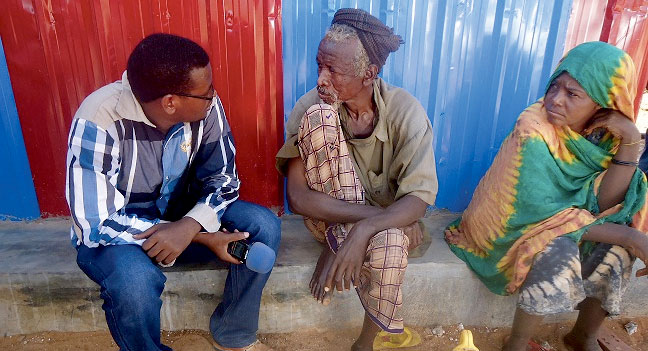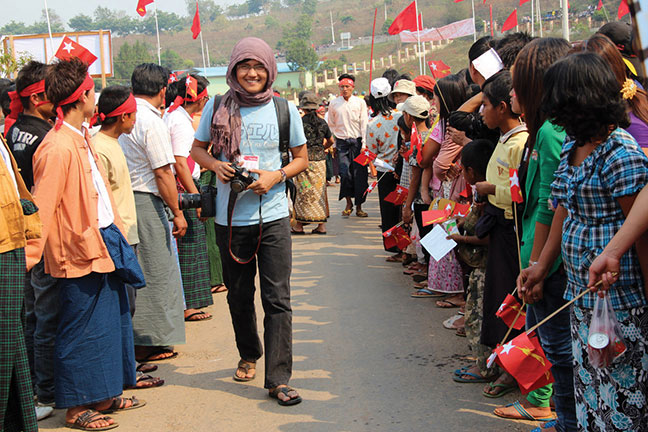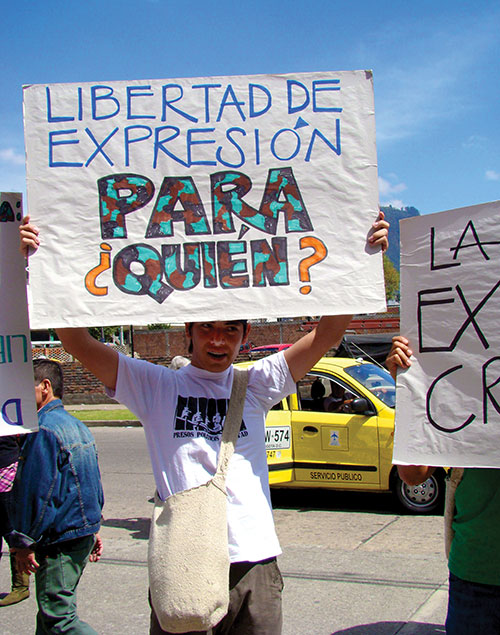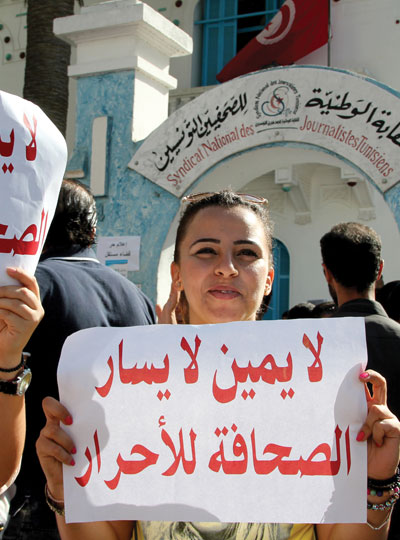AFRICA
In 2013, the media in several African countries was once again caught in the midst of overwhelming violence and humanitarian crises. In Mali, journalists struggled to overcome the impact of the armed rebellion and subsequent conflict that began in 2012, while an eruption of violence in December in 2013 in South Sudan put a fragile media sector under increasing pressure. In the Central African Republic, the need for humanitarian information escalated rapidly when a devastating conflict intensified towards the end of the year. In Somalia, the need for humanitarian information remained dire despite positive political and security developments, and in neighbouring Kenya, the September Westgate mall attack highlighted once again the need for a holistic and comprehensive approach to journalist safety.
IMS’ work across the African continent in 2013 emphasised our commitment to work with media that face some of the most trying challenges in the world. This work takes place in recognition of the fact that to survive and overcome armed conflicts and humanitarian crises, societies need a wide range of assistance. This includes short-term support to the media like broadcasting equipment that enables them to relay reliable information to and from populations in times of crisis, and more long-term comprehensive reinforcement in areas such as media law reform and the institutionalisation of professional practices that will allow the media to act a constructive role in later peacebuilding efforts.
Somalia
In 2013, Somalia’s journalists and the country’s population as a whole continued to suffer the impact of the country’s long-running armed conflict and humanitarian crisis. The IMS-supported Radio Ergo continued throughout the year to provide the population with indispensable humanitarian information covering everything from disaster mitigation and disease prevention, to livestock prices that empower farmers and pastoralists. Ergo also continued to act its key role in bridging a communication gap between Somalis and relief agencies, enabling humanitarian workers to better design their aid interventions.
An encouraging voice message left on Radio Ergo’s Freedom Fone service by a listener in Somalia’s northern Cayn region
“Radio Ergo’s broadcasts serve as a significant platform for us in order to profile and position humanitarian aid interventions, specific concerns, and general developments regarding Somalia,” said Alexandra Strand Holm, Regional Communications Officer, Danish Refugee Council.
Based on direct feedback from listeners calling the radio’s new Freedom Fone voice message service, Ergo expanded its programming to include a weekly segment focusing on the vast Somali diaspora, a drama series on the possible return to home of the huge amounts of internally displaced persons, and a polio vaccination awareness campaign.
Together with IMS, Ergo also facilitated the setup of a network of 18 Somali radio stations. A first-of-its-kind, the network will work to address the challenges of the Somali media sector by acting with a unified voice on media law issues, strengthening the capacities of journalists and media houses, and producing joint programming to promote peace, stability and development.
Central African Republic
2013 saw the Central African Republic embroiled in a devastating conflict and a growing humanitarian crisis. Intense fighting between the predominantly Muslim Séléka and the mainly Christian anti-balaka militia groups worsened towards the end of the year and in early 2014, with widespread massacres committed by the anti-balaka against Muslim civilians.
With massive security issues, fear resulting in self-censorship, destroyed infrastructure, and distrust between journalists and relief agencies, the Central African media was faced with an almost insurmountable challenge in covering the situation, found an IMS analysis conducted in December 2013 and January 2014. With large parts of the population left with little information on the crisis and with no ways to voice their urgent needs, the analysis found a clear need to boost humanitarian information and communication efforts.
South Sudan
2013 ended violently in South Sudan when brutal ethnic violence worsened in the Jonglei and Unity states from December onwards and left thousands dead and hundreds of thousands displaced. While the eruption of violence put the already fragile media under severe pressure, 2013 also included the encouraging endorsement of three media bills by the country’s parliament in July after years of advocacy and legal input from IMS’ local partner, the Association for Media Development in South Sudan (AMDISS). The three bills, which in early 2014 had yet to be passed by President Salva Kiir Mayardit, cover media regulation, access to information and public service broadcasting.
As part of our work under the UN Plan of Action on the Safety of Journalists and the Issue of Impunity, IMS together with AMDISS and the Union of Journalists of South Sudan (UJOSS) brought together journalists and security forces with the aim of enhancing the safety of the media and enabling constructive collaboration between the two groups. Similar initiatives in Iraq, Pakistan, and Colombia have shown that such dialogue-based initiatives help build mutual understanding of roles and responsibilities and pushes the media and security forces to recognise their shared goal of serving the public and of finding common ground in support of peaceful development.
Kenya
Fears that Kenya’s March Presidential election would lead to a repeat of the widespread violence of 2007-2008 did not materialise, although sporadic violence did break out in the lead-up to the vote. For the media, 2013 brought with it one of the most repressive pieces of legislation in the country’s history. Passed in December, the contentious Kenya Information and Communication (Amendment) Bill marked a major setback for press freedom in the country with a new government-controlled regulatory board authorised to impose hefty fines on media houses and journalists.
The killing of 67 people in the Al-Shabaab attack on Nairobi’s Westgate mall in September put journalists under both physical threat and emotional distress. At a meeting for editors and journalists convened by the Media Council of Kenya (MCK), editors said their journalists were untrained and unprepared to cover dangerous events like the Westgate siege.
To ensure a coordinated and comprehensive approach to improving the safety of Kenya’s journalists, MCK in collaboration with IMS began in late 2013 the development of a national strategy on the safety of journalists, which will provide rapid responses to urgent requests and also attend to the need for more structural changes in Kenya’s media environment. The strategy goes hand-in-hand with a journalist handbook published in 2014 by IMS and MCK on dealing with the psychological impact of traumatic experiences.
Mali
Although still marked by a severely fragile security situation and press freedom violations, Mali’s media did see some encouraging progress in 2013. This included slight improvements in the safety of journalists and a reopening of radio stations and newspapers closed in 2012 during the conflict in the country’s north. Despite this, the media still faced a number of basic hurdles to overcome, including widespread lack of electricity and infrastructure in the north and a press corps unaware of how to cover peace and reconciliation issues.
A radio journalist in Mali provides feedback after she took part in an IMS course on conflict sensitive journalism
Against this backdrop, our work in Mali in 2013 sought to enable the media to contribute to peacebuilding efforts and intercommunity dialogue in close collaboration with Media Foundation for West Africa and Panos Institute West Africa. In April and June, intensive workshops on conflict sensitive journalism and professional content production took place to strengthen the ability of the media to amplify the voices of people affected by the ongoing conflict, and to foster public debate between local communities and the institutions expected to provide for their needs.
Crucially, our work also focused on sharing journalistic content between the north and south of Mali to enable people to gain a better understanding of the conflict’s dynamics, and to enable them to overcome communal tension.

A journalist reports from outside Nairobi’s Westgate mall in September. Photo: Moses Omusula
From homeless to homeowners

A stringer from the IMS-supported Radio Ergo interviews Mohamud Mohamed Abdi and his wife in Baidoa, Somalia. Photo: Abdullahi Salad/Radio Ergo
Mohamud Mohamed Abdi and his wife were living in a tiny shack with their seven children in Baidoa in southern Somalia. Disabled through illness, the couple was earning a pitiful existence by sitting in the hot sun breaking rocks into smaller stones for construction. After the IMS-supported Radio Ergo aired their story, a group of young people began to raise money to help them.
“The story made us feel sad and we couldn’t ignore their suffering,” said Ibrahim Ahmed Ibrahim, one of the young people who contributed funds.
“What we found was that the family lived in an overcrowded, small, makeshift room and some family members often slept outside,” Ibrahim told Radio Ergo’s local reporter. “We then contacted local businesses in the community to raise funds and get support.”
The youth group managed to raise almost USD 3,000, and spent it on building a new house with two rooms, a kitchen, and a toilet. Abdi and his family were clearly overwhelmed: “We are very grateful to the youths. They have transformed our lives from being homeless to homeowners.”
ASIA
Ethnic conflict and crucial elections significantly affected media environments in South and Southeast Asia in 2013. The ethnic unrest in Myanmar cast a wider spotlight on Buddhist-Muslim tensions in the Southeast Asian region and highlighted the role and behaviour of both traditional and social media in conflict reporting.
In Pakistan, elections in May provided hope for democratic improvements, but the country instead saw journalists sandwiched between the Taliban and other interest groups who threatened media to control information flows. In Afghanistan, the prospect of milestone elections in 2014 and the withdrawal of international troops in 2015, sparked uncertainty and a deteriorating security environment for media and civil society.
Elections in Nepal in November were deemed largely successful, but Nepali media still suffered a spate of intimidations from political parties and youth groups, propagating self-censorship. Bhutan, on the other hand, took positive steps forward in civil and political liberties including in media freedoms following the government’s interest in reforming and modernising the media system.
IMS’ partnership approach, which focuses on working closely with other likeminded organisations and on aligning our priorities with those of the local media was a common feature throughout our work in South and Southeast Asia in 2013. The UN Plan of Action on the Safety of Journalists and the Issue of Impunity rolled out in Pakistan and Nepal by IMS, UNESCO, Open Society Foundations (OSF) and local partners, was a prime example of this.
Myanmar
The arrival of Myanmar’s first private daily newspapers on the streets of Yangon in April 2013 marked another important milestone in the string of reforms in the country’s media sector since 2011. Through partnerships with journalist associations, media workers, ministries and international media development organisations, and reinforced by a strong presence on the ground, IMS focused on media law reform in support of a safe media environment, strengthening institutions that educate and advocate the rights of journalists and professionalising journalistic content and skills.
As the first international organisation in Myanmar, IMS signed a Memorandum of Understanding to cement our cooperation with a range of key players, including the country’s newly established press council, journalist associations and the Ministry of Information, committing the signatories to work together on media law reform. Together with the Centre for Law and Democracy, IMS thus provided input to all tabled media laws, including the draft Broadcast Law and Public Service Law. Crucially, Myanmar’s first code of ethics for media, was drafted by the Interim Press Council with IMS’ support.
U Thiha Saw, Vice-chairman of Myanmar Journalists‘ Association
The need to address professionalism in journalism, and ethical standards in particular, was evident in the area of conflict reporting with examples of hate speech fueling existing tensions in conflict-ridden areas. IMS worked to promote a peaceful role of media during conflict and in peace negotiations through support to the Myanmar Peace Center which promotes peaceful dialogue. More than 400 journalists were trained in conflict sensitive journalism in 11 different cities, including in the conflict-plagued Rakhine and Kachin states.
In February, the fifth annual Yangon Photo Festival showcased some of Myanmar’s finest photo journalism work, the result of intensive multimedia photojournalism workshops for aspiring photojournalists organised by IMS in Yangon and in the conflict-ridden parts of the country.
“For some students, portraying life through the lens of a camera has been the first real opportunity to openly express themselves and show sides to Burmese life which have not been documented previously,” said trainer for IMS and curator of the festival, Christophe Loviny. IMS has trained more than 170 photojournalists since 2009, some of whom now work for international agencies such as Reuters and AFP.
Nepal
In Nepal, the media climate remained uncertain in 2013, although there were less physical attacks on journalists than in 2012, according to the US-based organisation Freedom House.
IMS’ efforts focused on building a safer working environment for journalists and working to push forward the UN Plan of Action on the Safety of Journalists and the Issue of Impunity together with UNESCO and OSF. Tied to this work was IMS’ collaboration with the National Human Rights Commission (NHRC) of Nepal to support its planned efforts to establish a national mechanism to improve the safety of journalists.
Pakistan
Pakistan was the fourth most dangerous country in the world for journalists in 2013. In a year of violent elections and worsening security, IMS focused on improving the capacity of journalists to report professionally and safely in crisis-affected areas and on improving relations between Afghan and Pakistani media.
The twin blasts that killed three journalists in Quetta in January 2013 highlighted the need to further strengthen the safety of journalists in the country. IMS’ package of safety activities carried out in partnership with OSF and UNESCO, included research on media safety and legal defence clinics for media lawyers in which they were trained in media law.
“If not for the IMS safety trainings we had in Quetta, more lives would have been lost due to the massive twin blasts in January,” said Tahir Ratore of the Pakistan Federal Union of Journalists.
The International Conference on Protection and Safety of Journalists in Islamabad in March brought together senior government members, local media and international groups to launch the UN Plan of Action on the Safety of Journalists and the Issue of Impunity in Pakistan. The Pakistan Coalition on Media Safety, comprising media unions, owners, media houses, and parliamentarians, was established at the meeting to coordinate work on media safety. A joint map tracking and monitoring media attacks has since been set up by the Coalition (http://mediasafety.pk) and discussions are ongoing about the appointment of a special prosecutor on media attacks and a legal aid fund for media.
The unstable political relationship between Pakistan and Afghanistan, prompted efforts to forge closer ties between journalists working on both sides of the border to improve informed coverage of cross-border issues and mutual understanding. A total of 14 journalist exchanges between the two countries took place facilitated by IMS and led one of Pakistan’s largest English-language dailies, Dawn, to station a correspondent in Kabul.
Afghanistan
In a year that would become one of the most violent ever for Afghan journalists and with milestone elections ahead in 2014, the value of the IMS-founded, country-wide Afghan Journalists’ Safety Committee (AJSC) became evermore clear. AJSC monitored violations in 32 out of 34 provinces and provided medical, legal and trauma assistance in 76 cases of journalists in danger. For journalists who work in an environment where they are purposely targeted for their work, AJSC was a source of support across the country.
The comprehensive safety package for journalists set up by IMS, but locally anchored with and run by AJSC included safety training for male and female journalists, practical measures such as a 24-hour hotline to which more than 400 calls from journalists in distress were made in 2013, and a safety fund for journalists in peril. The package also includes facilitating dialogues between government officials, security forces and the Afghan media to improve mutual understanding and focus on the safety of journalists. In 2013, the government set up a Media Violence Council to handle violations against media. Although a positive step forward, the Council has yet to really establish its independence.
In preparation for the April 2014 elections, IMS and AJSC held media election “shuras” (roundtables) with Afghan media workers about the process of elections, the roles, and the safety of the media. In addition to this, AJSC set up and tested a countrywide alert system for Afghan media workers which informed media workers by mobile phone text messages and social media about election-related events and threats against journalists in their province. Media workers in turn were provided with the skills to report back to AJSC headquarters from election campaigns around the country.
China
One of the many platforms for exercising Freedom of Expression is documentary filmmaking where attention is given to societal issues that the regular press does not cover. In November, the annual Danish documentary film festival CPH:DOX, a central proponent of the strong Danish tradition for documentary filmmaking, invited four Chinese directors and 10 Chinese documentary films to feature in the festival’s special segment on China entitled Between chaos and control. IMS facilitated their participation as part of our mandate to promote documentary filmmaking as a platform for expression and alternative voices.
Bhutan
The promising steps taken by the government of Bhutan in 2013 to move from a state-controlled towards a more democratic media environment was a highlight in the South Asian region, which otherwise primarily encountered setbacks in terms of press freedom. IMS was pleased to assist the government and the Swiss Agency for Development and Cooperation (SDC) in designing a three-year media development programme that addresses media regulation, community media outreach, and sustainability of private media. IMS and the Centre for Law and Democracy also provided technical advice for the formulation of an Access to Information law, and will continue in an advisory role to support the build-up of a new democratic media sector.

Journalists interview a young girl in Peshawar, Pakistan. Photo: Civic Action Resources
A time to document history in Myanmar

Min Zayar Oo on the campaign trail with Aung San Suu Kyi. Photo: Pyay Kyaw Myint
He started out as an award-winning classical pianist, but sold his piano to buy a camera. A few months later, he had his first international breakthrough and now belongs to the new generation of photojournalists in Myanmar set on documenting history in the country.
Min Zayar Oo is one of the many young photographers who has taken part in IMS-organised workshops in Yangon on photojournalism.
“In 2011 when I began taking photos, I primarily focused on landscape photography,” Min Zayar Oo explained. “But I also wanted to take pictures of something more important, more powerful, but didn’t know where to start.”
At the workshops, students were asked to tell a story through a series of images, combining photos with sound and text. Min Zayar Oo first chose to depict the beauty of giving birth, but instead ended up focusing on the unhygienic conditions in the hospital.
“I always thought a good picture was about technique, and having the best camera. But the workshops taught me that it is not about the camera. It is about the subject, about the message you want to convey with your photos and about ensuring that this message is important for the subject of your pictures.”
Depicting the lives of everyday people and the country’s ongoing conflicts remains a sensitive undertaking in Myanmar, although things are slowly changing. Since 2009, IMS has trained over 170 photojournalists in the art of telling stories with photos accompanied by text and sound for both digital and traditional media. See some of the amazing photo series here.
LATIN AMERICA
A climate of violence against and intimidation of journalists and media workers persisted in 2013 in Colombia, Honduras and Mexico as the justice systems in all three countries faced increasing exposure for their inability to break down a prevailing culture of impunity in the Latin American region.
From a near failed state in Honduras to a press corps still reeling from state surveillance in Colombia, the unifying factor tying together the regions of Central and South America was a toxic mix of intimidation and persecution of journalists by both organised crime groups and security forces.
Reporters in Colombia, covering the months-long anti-government demonstrations by peasant farmers in northern Catatumbo, were violently targeted by all sides.
In Honduras, allegations of law enforcement engaging in corruption and forming police death squads dogged the media with simultaneous threats by organised crime groups on the rise.
Similar to their Honduran colleagues, journalists in Mexico continued to be targeted, attacked and disappeared as competing drug cartels, law enforcement and the military battled throughout the country. Self-censorship increased as several media outlets sought refuge in this last safety resort.
Colombia
In Colombia, IMS aims to work with media outlets and media support groups to encourage a positive and proactive role for the media in consolidating peace. To assist local media in addressing the rollout of the peace process, in 2013 IMS developed a new project to support the media’s role in promoting conflict reduction and shedding light on the peace process and the road to transition in three high-risk zones.
Based on a possible positive outcome in the peace talks in Havana, the time period of the programme will also involve the implementation phase following the signing of a peace accord between the Colombian government and the FARC. This work will focus on enhancing conflict sensitive journalism reporting by local media outlets and will also involve extensive work with the security forces operating in these areas.
Honduras
This safety work will be replicated in Honduras in 2014, where IMS aims to combine safety training and conflict sensitive journalism with a range of media outlets to boost coverage of sensitive topics like drug trafficking, government corruption, and land conflicts through a new investigative journalism programme.
In the last quarter of 2013, as part of the UN Plan of Action on the Safety of Journalists and the Issue of Impunity, IMS, together with Open Society Foundations, pushed forward plans for the new year to establish a new safety fund for journalists in Mexico and to support safety monitoring by local press freedom groups in both Honduras and Mexico.

A man holds up a sign reading “Freedom of Expression for whom?” in Bogotá, Colombia. Photo: Andrés Monroy Gómez






